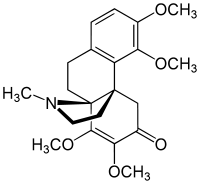Hasubanonine
Hasubanonine is a member of the hasubanan family of alkaloids. The alkaloid with an isoquinoline substructure has the molecular formula of C21H27NO5.[1] The enantiomer of the natural product is being studied as a potential painkiller.[2] Hasubanonine is structurally related to the morphinan class of opioid analgesics.
 | |
| Names | |
|---|---|
| Systematic IUPAC name
3,4,7,8-Tetramethoxy-17-methyl-7,8-didehydrohasubanan-6-one | |
| Other names
Hasubanonine | |
| Identifiers | |
3D model (JSmol) |
|
| ChemSpider | |
PubChem CID |
|
| UNII | |
CompTox Dashboard (EPA) |
|
| |
| |
| Properties | |
| C21H27NO5 | |
| Molar mass | 373.449 g·mol−1 |
Except where otherwise noted, data are given for materials in their standard state (at 25 °C [77 °F], 100 kPa). | |
| Infobox references | |
The enantioselective total synthesis of (–)-hasubanonine and related natural products, (−)-runanine, (−)-delavayine, and (+)-periglaucine B were first achieved by Prof. Seth Herzon and co-workers at Yale University in 2011. [3]
References
- Hasubanonine
- "Y. Chemists hoping to ease pain". Deseret News. August 17, 2006.
- Herzon, Seth B.; Calandra, Nicholas A.; King, Sandra M.; McCarthy, M. C.; Gauss, J. (2011). "Efficient Entry to the Hasubanan Alkaloids: First Enantioselective Total Syntheses of (−)-Hasubanonine, (−)-Runanine, (−)-Delavayine, and (+)-Periglaucine B". Angewandte Chemie International Edition. 50 (38): 8863–8866. doi:10.1002/anie.201102226. PMID 21638524.
This article is issued from Wikipedia. The text is licensed under Creative Commons - Attribution - Sharealike. Additional terms may apply for the media files.